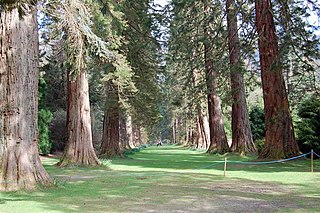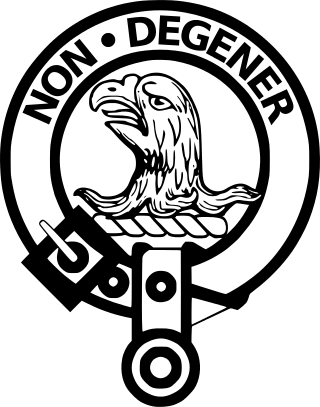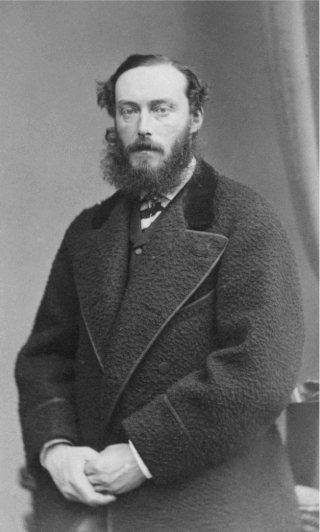Related Research Articles
Andrew Colvile was a Scottish businessman, notable as the governor of the Hudson's Bay Company, a huge organisation set up for the North American fur trade but also instrumental in the early history of Canada. He was also chairman of the West India Docks.

Benmore Botanic Garden is a large botanical garden situated in Strath Eachaig at the foot of Beinn Mhòr, on the Cowal peninsula, in Argyll and Bute, Scotland. The gardens are on the west side of the A815 road from Dunoon, between the Holy Loch and Loch Eck, and include footbridges across the River Eachaig. It is one of the sites of Royal Botanic Garden Edinburgh.

Clan Lamont is a Highland Scottish clan. The clan is said to descend from Ánrothán Ua Néill, an Irish prince of the O'Neill dynasty, and through him Niall Noigíallach, High King of Ireland. Clan Ewen of Otter, Clan MacNeil of Barra, Clan Lachlan, and Clan Sweeney are also descendants of Ánrothán. Traditional genealogy would therefore include Clan Lamont among the descendants of Conn Cétchathach.

Clan Wedderburn is a Lowland Scottish clan.

Charles Rose Ellis, 1st Baron Seaford was a British politician, sugar planter, and slave holder.
Ambrose Madison was an American planter and politician in the Piedmont of Virginia Colony. He married Frances Taylor in 1721, daughter of James Taylor, a member of the Knights of the Golden Horseshoe Expedition across the Blue Ridge Mountains from the Tidewater. Through her father, Madison and his brother-in-law Thomas Chew were aided in acquiring 4,675 acres in 1723, in what became Orange County. There he developed his tobacco plantation known as Mount Pleasant The Madisons were parents of James Madison Sr. and paternal grandparents of President James Madison.

A slave insurrection started on Sankt Jan in the Danish West Indies on November 23, 1733, when 150 African slaves from Akwamu, in present-day Ghana, revolted against the owners and managers of the island's plantations. Led by Breffu, an enslaved woman from Ghana, and lasting several months into August 1734, the slave rebellion was one of the earliest and longest slave revolts in the Americas. The Akwamu slaves captured the fort in Coral Bay and took control of most of the island. They intended to resume crop production under their own control.

Sir Norman Lamont, 2nd Baronet was a Scottish Liberal Party politician, sugar planter in Trinidad, and a recognised authority on agriculture.

James Lamont was a Scottish explorer and author, particularly known for his voyages in the Arctic in 1858–59 and 1869–71, which were the topic of his two books, Seasons with the Sea-Horse (1861) and Yachting in the Arctic Seas (1876). He was a fellow of the Geological Society of London and the Royal Geographical Society. He served as the Liberal Member of Parliament for Buteshire (1865–68), and was created a baronet in 1910.
The Lamont Baronetcy, of Knockdaw in the Parish of Inverchaolain in the County of Argyll, was a title in the Baronetage of the United Kingdom. It was created on 16 July 1910 for the Scottish explorer and Liberal Member of Parliament, James Lamont. He was succeeded by his son, the second Baronet, also a Liberal politician. He never married and the title became extinct on his death in 1949.

Plantation complexes were common on agricultural plantations in the Southern United States from the 17th into the 20th century. The complex included everything from the main residence down to the pens for livestock. Until the abolition of slavery, such plantations were generally self-sufficient settlements that relied on the forced labor of enslaved people.

George Ferguson was the fourth Laird of Pitfour, a large estate in the Buchan area of Aberdeenshire, Scotland, that became known as The Blenheim of the North.

Captain William J. Minor was an American planter, slave owner, and banker in the antebellum South. Educated in Philadelphia, he lived at the Concord plantation in Natchez, Mississippi, and served as the second President of the Agricultural Bank. He was the owner of three large sugar plantations in Louisiana and supported the Union during the Civil War for the stability of the sugar trade.

James Baillie was a Scottish slave owner, merchant, and Member of Parliament for Horsham between 1792 and 1793.
James Blair was a Ulster-Scots owner of plantations in the West Indies. He entered Parliament as a Tory in 1818 to protect the interests of slave-owners. Blair sat in the House of Commons from 1818 to 1830, and later from 1837 to 1841.
William Smith of Carbeth Guthrie (1787–1871) was a 19th-century Scottish sugar trader who served as Lord Provost of Glasgow from 1822 to 1824.
Simon Taylor was a Jamaican-born planter and politician. Taylor was the wealthiest planter on the island, according to its governor, and died leaving an estate estimated at over £1 million, equivalent to £69,416,794 in 2021.
William Atherton, was a merchant and wealthy landowner from Lancashire, England, who operated and co-owned sugar plantations in the former Colony of Jamaica. He was a slave owner, as well as an importer of slaves from Africa.
Green Park Estate was one of several sugar plantations owned by William Atherton and his heirs. It was located in Trelawny Parish, south of Falmouth, Jamaica. By the early nineteenth century, at least 533 people were enslaved there producing mainly sugar and rum.
Mercers Creek Division is a division of Saint Peter, Antigua and Barbuda. It also coincides with the borders of enumeration district 51303, part of Vernons.
References
- 1 2 3 4 5 6 7 George Young (September 2008), One of the most important events of Lamont history, Presentation during the 113th Clan gathering of Clan Lamont in Knockdow House
- ↑ Mullen, Stephen (2018). "John Lamont of Benmore: A Highland Planter who Died 'in harness' in Trinidad" (PDF). Northern Scotland. Edinburgh University Press. 9 (1): 44–66. doi:10.3366/nor.2018.0144. ISSN 0306-5278.
- 1 2 3 Lamont, John (21 March 2017). "Summary of Individual". Legacies of British Slave-ownership. Retrieved 21 March 2017.
- ↑ Lionel Mordant Fraser (3 April 2013). History of Trinidad from 1781-1839 and 1891-1896. Routledge. p. 131. ISBN 978-1-136-25877-0.
- ↑ The Scottish Jurist: Containing Reports of Cases Decided in the House of Lords, Courts of Session, Teinds, and Exchequer, and the Jury and Justiciary Courts. Michael Anderson. 1856. pp. 307–.